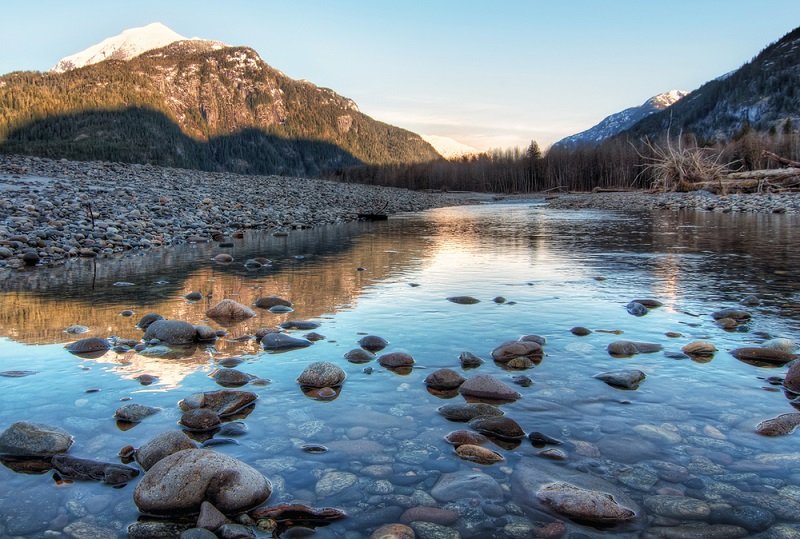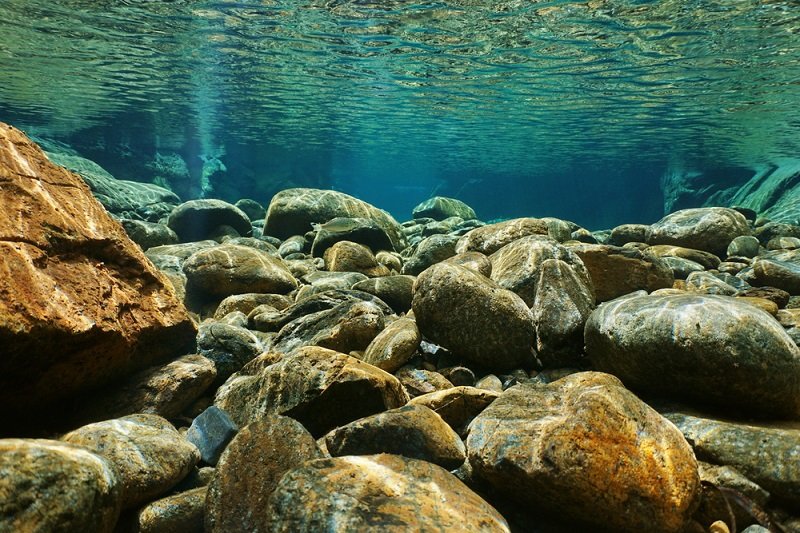Everyone at some point has walked near a river or a creek and noticed all of the rocks have a rounded, smooth shape to them. They make great for hopping along to cross a creek bed, or they are the perfect skipping stones. But all together, they have the same defining shape that all rocks in all rivers around the world seem to share. Why is that?
Why Are River Rocks Smooth?
Rock shapes and sizes are due to a process known as erosion. Erosion is the geological process by which sediment, including rocks and boulders, are transported and worn down by nature. The major driving forces of erosion are wind, water, ice, and gravity. These methods wear down and weather rocks from the jagged mountain tops all the way into the fine sand we see on the beach.
Two Types of Erosion

There are two main types of erosion, chemical and physical. Both methods break down rocks and result in transportation, moving them from “source” to “sink”, or from their original position to their final resting position. Often times, both are interconnected and happening simultaneously. Erosion is constantly acting on rocks, no matter what the environment is.
Chemical erosion
Chemical erosion is the breakdown of the rocks basic building block by chemical reactions. Have you ever seen an old statue that is worn down and stained? That is the result of acid rain on carbonate rocks dissolving the calcium and magnesium in the original rock. Chemical erosion break down a rock on the microscopic level through acids, oxidation, and disintegration.
Physical erosion
Physical erosion is the biggest reason we have similar river rocks all over the world. Physical forces like wind, water, ice, and gravity move rocks and smash and bump them against each other. Just like a rock tumbler, the rocks lose their jagged edges and then abrasion rounds out all the points that stick out or protrude as they tumble down mountains and through rivers.
Geologic Time Scales
All of these forces are working on geologic time scales. In the grand sense of things, geologic time is an abstract concept to understand. We can’t imagine ten thousand years, or even ten millions of years. However, many geologic processes take place over tens or even hundreds of millions of years.
Time is the necessity of erosional forces. While throwing a rock off a mountain just a few times may not make it smooth, over millions of years the effects of tumbling will eventually smooth and polish the rocks surface while rounding its jagged shape. This is knows as abrasion and collision theory in geology, and scientists have even reproduced these results in complex laboratory experiments.
River Rock Lifecycle

The following is an example of the typic lifecycle of a river rock from “source” to “sink”.
Source Rock
We all know water flows down hill. So the top of the hill must be where the rocks began their journey. Weathering from ice, wind, water, or gravity causes natural fractures and splits in the rock. These break off and begin their travels of becoming river rocks.
Transport
The source rock is now free to move down hill into the lowest point, usually where a river has formed either from snowmelt or from higher elevation water tables. The rock joins all the other rocks and begins its travel full of collision and abrasion, smashing and tumbling on the bottom of the river.
Rounding
The rock which was once jagged and full of sharp edges has now lost its edges from all the jostling and crashing in the water. What once resembled a rectangular slab of granite with sharp edges, is now starting to take a rounder shape as it tumbles and beings to take on an ellipsoid or oval shape. Over time, the points on either end get smaller and smaller and soon it resembles a round ball that is a fraction of its original size.
Polishing
The small round cobble that used to be a large rock has lost all its sharp edges and odd protrusions. Now it tumbles slowly for years and becomes polished as sediment washes over it for years. Sand and silt slowly rub and abrade against it until the outside is smooth to the touch, all the rough surfaces have been erased over time.
Deposition
The rock that began at the mountain top has now settled in the valley in the slow moving stream of an offshoot of a larger river system. Now the only time it transports is during massive flood events that happen once every several hundred years. It will still be worn down by sediment in the slow moving water resulting in a smooth surface texture and polished appearance, but the rate of weathering has slowed down.
Transformation
After many thousands or millions of years of being abraded by sand and silt, the rock has worn down to the size of a pebble. Many years after that, the individual grains are all that is left and that once large boulder has been broken down into its most basic grains. The rock has now become sediment and would be considered a course sand, forever abrading other rocks in the river.
- Online rock and mineral club for collectors of all levels!
- Find community with like-minded rock and mineral enthusiasts.
- Monthly Giveaways!
- Free Access to Entire Digital Library of Products (annual memberships)


